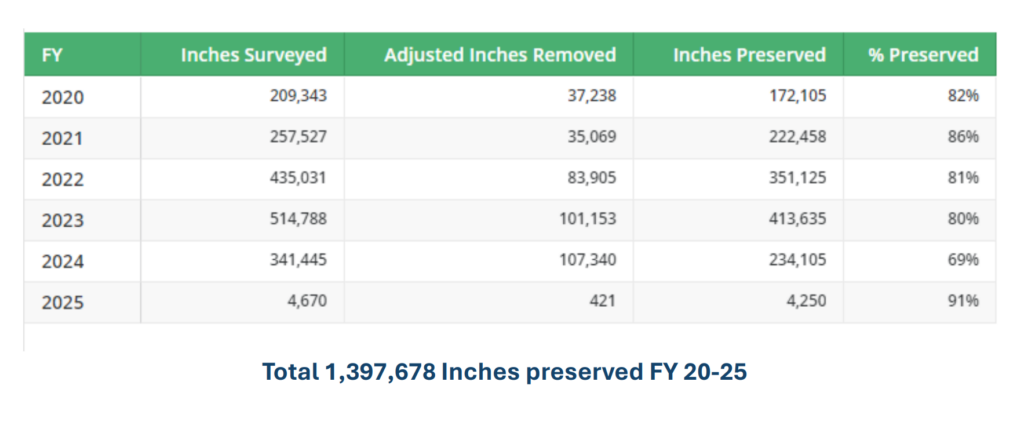Tree ordinances continue to take root in Austin
Thursday, November 14, 2024 by
Hunter Simmons Since 2020, Austin’s tree regulations and protections have preserved a total of 1,397,678 inches of trees within city limits. Thus far in Fiscal Year 2025, 4,670 inches of trees have been surveyed and 4,250 inches have been preserved, with 91 percent of inches surveyed being preserved.
That’s what the Environmental Commission learned during a presentation at its regular Nov. 6 meeting from city arborist Naomi Rotramel regarding Austin’s tree regulations and protections.

Credit: Development Services Department
Austin’s first tree ordinance was adopted in 1983, thanks in large part to the efforts of City Council Member Margret Hofmann. Hofmann immigrated from Germany to the United States in 1946. Having witnessed the destruction that World War II had left on her country, Hofmann began organizing in support of natural spaces in her new home, Austin. Today, a cluster of live oak trees facing City Hall holds the name Margret Hofmann Oaks in honor of her work for the city.
In 2010, the Heritage Tree Ordinance was passed, protecting a subset of trees deemed “heritage trees” due to their species, age and size – when they reach a 24-inch diameter. These are considered irreplaceable due to their ecological and aesthetic value. Accordingly, heritage trees garner stringent guidelines and greater protection from removal or impact. The ordinance enumerates the following list of heritage trees: Texas Ash, Bald Cypress, American Elm, Cedar Elm, Texas Madrone, Bigtooth Maple, Pecan, Arizona Walnut, Eastern Black Walnut and all oaks.
“The tree protection ordinances lie within the Land Development Code,” Rotramel said. The code outlines criteria for removal, requiring a specific tree to prevent reasonable access or to be dead, diseased or an imminent hazard.
Additionally, the code includes the Environmental Criteria Manual, which is used as a reference for environmental policies, including tree protection guidelines. It supplements the tree ordinance and provides detailed criteria for protecting, maintaining, and enhancing Austin’s urban forest. These guidelines offer specific standards for tree protection during construction and development and interpret the Land Development Code’s tree-related policies for practical, consistent application.
Most damage to trees occurs due to development. Trees are protected through a review of plans and enforcement of tree protection on active construction. Tree Preservation Criteria are the rules the city uses to determine whether a tree is likely to survive a construction project or other impacts.
Tree Preservation Criteria looks at the critical root zone, a circle around the tree with a radius in feet equal to the diameter in inches of the trunk. The half and quarter critical root zones are smaller circles within the zone with further restrictions. “We all think of trees as the same above and below. That is not really how trees grow. In reality, it is more of like a pancake. We don’t regulate all of that pancake in the full extent of the critical root zone.”
These framework components ensure that the city maintains a healthy urban forest while accommodating growth and development, underscoring the city’s dedication to environmental stewardship.
For reference, Austin’s urban forest currently has over 33 million trees. The benefits of protecting trees are vast. Research from the Texas A&M Forest Service affirms that trees improve air quality, help reduce flood impacts, reduce erosion, and provide food, shelter and nesting for diverse wildlife. Urban trees can cool the air up to 8 degrees Celsius, and their shade and wind protection reduce energy use. From a societal view, trees contribute to connections with nature that improve people’s health outcomes and contribute to an environment where people feel connected to their community, provide a sense of place, and soften the sharp outlines of concrete, metal and glass of urban and suburban cityscapes. From a business perspective, shoppers spend more time and money in shopping areas with businesses that have good tree coverage.
Because of these known benefits trees provide, the city’s website states that their goal is always: “To maintain the health and integrity of our urban forest, to strive to plant trees, preserve trees during land development, and care for existing trees. Supporting a healthy future forest takes a community of stewards.”
Photo made available through a Creative Commons license.
The Austin Monitor’s work is made possible by donations from the community. Though our reporting covers donors from time to time, we are careful to keep business and editorial efforts separate while maintaining transparency. A complete list of donors is available here, and our code of ethics is explained here.
You're a community leader
And we’re honored you look to us for serious, in-depth news. You know a strong community needs local and dedicated watchdog reporting. We’re here for you and that won’t change. Now will you take the powerful next step and support our nonprofit news organization?







